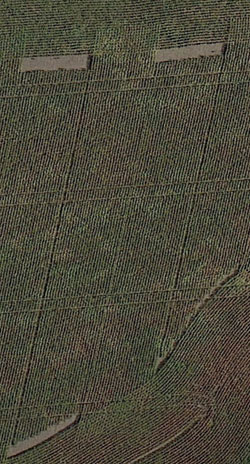Planting season is nearly upon us and it won't be long until field activities are in full swing. After visiting with producers all across the state over the winter, it's clear that the adoption of precision ag technologies continues in many operations. Automatic section control (ASC) or swath control systems are just one example of current technology that many producers are investing in. ASC systems can be installed or activated on planters and sprayers as well as liquid and dry fertilizer applicators.

Figure 1. Aerial photograph illustrating headland and pass-to-pass overlap and skip areas resulting from incorrect GPS offsets. (Source: Google Earth)
The goal of these systems is to reduce over-application of crop inputs by turning off control sections (planter units or boom sections, for example) as they pass over previously covered areas. ASC systems use GPS to track these areas in real-time as field operations are occurring. For this to work as intended, it is critical that equipment dimensions be correctly entered in the in-cab monitor. This ensures that field mapping is recorded correctly by the monitor and control sections are managed properly. Improper measurements could (in the case of sprayers) result in double application of pesticides to an area. The consequences would be an increase in input costs as well as potential crop damage resulting from exceeding labeled rates.
Why Accurate ASC Measurements Matter
In most cases, we have to measure distances from the GPS antenna (generally on top of the cab) to other points on the equipment. For most planters, distance from the GPS antenna to the drawbar pin is measured, and then the distance from the drawbar to the planter units is measured and entered. For sprayers, distance from the GPS antenna to the centerline of the boom must be measured and entered. For all of these systems, control section widths and offsets from the centerline (of the boom or planter) must be entered.
Entering an improper measurement for the front-to-back offset results in a fairly consistent overlap or skip when exiting or entering headlands as shown in the top of Figure 1. This error is also shown in the bottom of the figure as the row shut-offs were controlling the planter's row units along the curved edge of the field. Also visible is an error in the left-to-right offset, resulting in alternating wide and narrow guess rows on subsequent passes of the planter. While these problems are evident on planters (pre-emergence), they may be less visible with sprayers or fertilizer application equipment; however, in both instances, the problems are the same.
How To Take ASC Measurements
When taking measurements, refer to the operator's manual to ensure that you're measuring the proper distance for different settings and entering those properly in the correct units (feet or inches). Because of height differences, it can be difficult to measure from the GPS antenna on top of the cab down to the drawbar. Using a level and plumb-bob can improve these measurements in some cases. If you notice issues (planter skips and overlaps, weed pressure, insufficient nitrogen application, for example) near headland areas, it may be a sign to check your GPS offset settings if you're using ASC technology for those operations.


![[Technology Corner] A Big Step Forward for Interoperability & Data Sharing](https://www.precisionfarmingdealer.com/ext/resources/2025/12/12/A-Big-Step-Forward-for-Interoperability--Data-Sharing.webp?height=290&t=1765565632&width=400)


